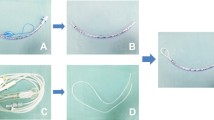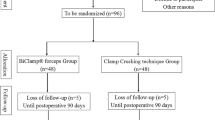Abstract
Blood loss during liver transection and ischemia-reperfusion injury associated with hepatic inflow occlusion are significant drawbacks during liver surgery. Sixteen patients underwent liver resection using the Monopolar Floating Ball (FB) plus LigaSure (LS) diathermy without occlusion of the hepatoduodenal ligament (group FB-LS). The liver parenchyma was precoagulated using the FB, and the uncovered tiny vessels were sealed using LS. Surgical outcomes were retrospectively compared with 16 well matched patients who underwent liver resection using the conventional clamp crushing method with Pringle’s maneuver (group CC). The amount of blood loss during liver transection was significantly less in group FB-LS than in group CC [200 ml (0–990 ml) vs. 480 ml (120–1800 ml);p = 0.006]. The median time it took to complete the liver transection was significantly longer in group FB-LS than in group CC [144 minutes (43–335 minutes) vs. 58 minutes (18–94 minutes); p < 0.0001]. Hepatic inflow occlusion was temporally used in five patients in group FB-LS to achieve hemostasis in hepatic venous tributaries for 6,10, 19, 26, and 61 minutes, respectively. Using these two electronic devices allows liver resection to be safely performed, with the advantage of minimal blood loss and a reduced inflow occlusion period compared to the conventional method. The major disadvantage may be a slower transection speed. A prospective randomized trial is needed to clarify the clinical benefits of liver resections performed using this novel technique.
Résumé
Les pertes sanguines lors de la résection hépatique et les lésions d’ischémie-reperfusion en rapport avec la manoeuvre de Pringle (occlusion du pédicule hépatique) sont parmi les inconvénients les plus importants dans la chirurgie hépatique. Seize patients ont eu une résection hépatique utilisant soit la coagulation monopolaire «Floating Ball (FB)» plus « LigaSure (LS)» sans occlusion du pédicule hépatique (groupe FB-LS). Le parenchyme hépatique a été précoagulé par la technique FB et les vaisseaux ainsi découverts ont été coagulés par la LS. L’évolution chirurgicale a été comparée rétrospectivement à celle de 16 patients bien appariés qui ont eu une résection hépatique par des techniques conventionnelles (Kelly clasie) sous clampage pédiculaire (groupe CC). La quantité de sang perdu pendant la résection hépatique a été significativement moins élevé dans le groupe FB-LS que dans le groupe CC [200 (0–990) vs. 480 (120–1800) ml, p = 0.006]. La durée médiane de la résection hépatique a été significativement plus longue dans le groupe FB-LS que dans le groupe CC [144 (43–335) vs. 58 (18–94) min, p < 0.0001]. Dans le groupe FB-LS, l’occlusion par clampage pédiculaire hépatique a été utilisé temporairement chez cinq patients afin d’obtenir une hémostase active à partir des branches hépatiques veineuses pendant 6, 10, 19, 26, et 61 minutes. Par l’utilisation de ces deux appareils électroniques, la résection hépatique peut être réalisée avec sécurité avec un minimum de pertes sanguines et une durée d’occlusion pédiculaire réduite par rapport aux techniques conventionnelles. L’inconvénient majeur est la durée plus longue nécessaire à la transection. Une étude prospective randomisée est nécessaire pour clarifier les bénéfices réels pour les résections hépatiques avec cette nouvelle technique.
Resumen
La hemorragia en la sección transversal del hígado y el síndrome de isquemia-reperfusión tras la oclusión del flujo sanguíneo hepático constituyen serios problemas en la cirugía del hígado. 16 pacientes fueron sometidos a una resección hepática sin oclusión del ligamento hepatoduodenal empleando el Monopolar Floating Ball (FB) y la diatermia Liga Sure (LS). El parénquima hepático fue cauterizado utilizando el FB y los pequeños vasos sellados empleando el LS. Los resultados quirúrgicos fueron comparados retrospectivamente con un grupo homogéneo de 16 pacientes sometidos a resección hepática convencional utilizando la pinza de forcipresión de Storm junto con la maniobra de Pringle (grupo CC). La hemorragia tras la sección hepática fue significativamente menor en el grupo FB-LS que en el grupo CC [200 (0–990) trente a 480 (120–1800) ml, p = 0.006]. La duración media de la sección hepática fue significativamente mayor en el grupo FB-LS que en el grupo CC [144 (43–335) trente a 58 (18–94) minutes, p < 0.0001]. 5 pacientes del grupo FB-LS precisaron de oclusión temporal del flujo sanguíneo hepático, durante 6, 10, 19, 26, y 61 minutes para realizar la hemostasia de venas hepáticas colaterales. Utilizando dos aparatos electrónicos, la resección hepática puede efectuarse, sin peligro alguno, produciéndose una hemorragia escasa, al mismo tiempo que se minimiza el periodo de oclusión del flujo sanguíneo hepático con relación a la técnica operatoria convencional. La gran desventaja de este proceder viene dada por la lenta velocidad de la sección hepática. Se precisan estudios prospectivos randomizados para aclarar la utilidad clínica de la resección hepática efectuada mediante esta nueva técnica.
Similar content being viewed by others
References
Yamamoto J, Kosuge T, Takayama T, et al. Perioperative blood transfusion promotes recurrence of hepatocellular carcinoma after hepatectomy. Surgery 1994;115:303–309
Makuuchi M, Hasegawa H, Yamazaki S. Ultrasonically guided subsegmentectomy. Surg. Gynecol. Obstet. 1985;161:346–350
Pringle JH. Notes on the arrest of hepatic haemorrhage due to trauma. Ann. Surg. 1909;48:541–549
Yamamoto Y, Ikai I, Kume M, et al. New simple technique for hepatic parenchymal resection using a Cavitron ultrasonic surgical aspirator and bipolar cautery equipped with a channel for water dripping. World J. Surg. 1999;23:1032–1037
Takayama T, Makuuchi M, Kubota K, et al. Randomized comparison of ultrasonic vs clamp transection of the liver. Arch. Surg. 2001;136: 922–928
Tabuse K, Katsumi M, Kobayashi Y, et al. Microwave surgery: hepatectomy using a microwave tissue coagulator. World J. Surg. 1985;9: 136–143
Papachristou DN, Barters R. Resection of the liver with a water jet. Br. J. Surg. 1982;69:93–94
Kokudo N, Kimura H, Yamamoto H, et al. Hepatic parenchyma transection using ultrasonic coagulating shears: a preliminary report. J.HPB Surg. 2000;7:296–298
Sugo H, Mikami Y, Matsumoto F, et al. Hepatic resection using the harmonic scalpel. Surg. Today 2000;30:959–962
Yamada T, Sasaki Y, Imaoka S, et al. Practical usefulness of bipolar scissors in hepatectomy. Hepatogastroenterology. 2002;49:597–600
Grace PA. Ischaemia-reperfusion injury. Br. J. Surg. 1994;81:637–647
Makuuchi M, Mori T, Gunvén P, et al. Safety of hemihepatic vascular occlusion during resection of the liver. Surg. Gynecol. Obstet. 1987;164: 155–158
Clavien PA, Yadav S, Sindram D, et al. Protective effects of ischaemic preconditioning for liver resection performed under inflow occlusion in humans. Ann. Surg. 2000;232:155–162
Makuuchi M, Kosuge T, Takayama T, et al. Surgery for small liver cancers. Semin. Surg. Oncol. 1993;113:295–302
Yamamoto J, Sugihara K, Kosuge T, et al. Pathologic support for limited hepatectomy in the treatment of liver metastases from colorectal cancer. Ann. Surg. 1995;221:74–78
Kokudo N, Miki Y, Sugai S, et al. Genetic and histological assessment of surgical margins in resected liver metastases from colorectal carcinoma. Arch. Surg. 2002;137:833–840
Torzilli G, Makuuchi M, Inoue K, et al. No-mortality liver resection for hepatocellular carcinoma in cirrhotic and noncirrhotic patients. Arch. Surg. 1999;134:984–992
Horgan PG. A novel technique for parenchymal division during hepatectomy. Am. J. Surg. 2001;181:236–237
Author information
Authors and Affiliations
Corresponding author
Rights and permissions
About this article
Cite this article
Sakamoto, Y., Yamamoto, J., Kokudo, N. et al. Bloodless liver resection using the Monopolar Floating Ball plus Ligasure diathermy: Preliminary results of 16 liver resections. World J. Surg. 28, 166–172 (2004). https://doi.org/10.1007/s00268-003-7167-5
Issue Date:
DOI: https://doi.org/10.1007/s00268-003-7167-5




